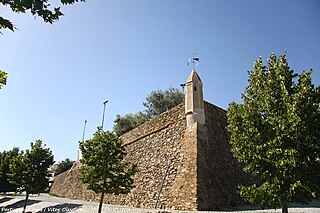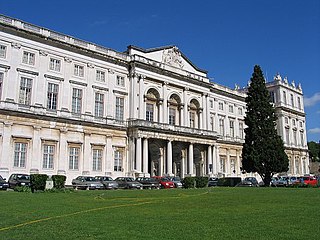
The Castle of Almourol is a medieval castle atop the islet of Almourol in the middle of the Tagus River, located in the civil parish of Praia do Ribatejo, 4 kilometres (2.5 mi) from the municipal seat of Vila Nova da Barquinha, in Portugal's Oeste e Vale do Tejo region. The castle was part of the defensive line controlled by the Knights Templar, and a stronghold used during the Portuguese Reconquista.

São Jorge Castle, sometimes known in English as Saint George's Castle, is a historic castle in the Portuguese capital of Lisbon, located in the freguesia of Santa Maria Maior. Human occupation of the castle hill dates to at least the 8th century BC while the oldest fortifications on the site date from the 2nd century BC. The hill on which Saint George's Castle stands has played an important part in the history of Lisbon, having served as the location of fortifications occupied successively by Phoenicians, Carthaginians, Romans, and Moors, before its conquest by the Portuguese in the 1147 Siege of Lisbon. Since the 12th century, the castle has variously served as a royal palace, a military barracks, home of the Torre do Tombo National Archive, and now as a national monument and museum.

Restorers Square is a public square in the city of Lisbon, Portugal. It is located at the southeast end of Avenida da Liberdade, near Rossio square.

The Fort of São Sebastião de Caparica also known as the Tower of São Sebastião or Fortress of the Old Tower is a medieval fortification located in Monte da Caparica, civil parish of Caparica, in the municipality of Almada, in the Portuguese central region of Península de Setúbal.

The Castle of Santa Maria da Feira is a Portuguese castle in the municipality of Santa Maria da Feira, district of Aveiro. Emblematic of Portuguese medieval military architecture, the Castle of Santa Maria da Feira is one of the monuments that best reflects the diversity of defenses used during the Middle Ages, having been instrumental in the process of Reconquista and autonomy of the County of Portugal. It has been listed as a National monument since 1910.

The Casa dos Bicos is a historical house in the civil parish of Santa Maria Maior, in the Portuguese municipality of Lisbon. The house, built in the early 16th century in the Alfama neighbourhood, has a curious façade of spikes, influenced by Italian Renaissance palaces and Portuguese Manueline styles. It survived the disastrous 1755 Lisbon earthquake that destroyed much of the city, but over time was abandoned as a residence and used as a warehouse. After a 20th-century renovation, it became the headquarters of the José Saramago Foundation and a location of the Museum of Lisbon.

The Praça do Império is a city square and park situated adjacent to principal monuments and tourist attractions in the civil parish of Belém, municipality and Portuguese capital of Lisbon.

The Glória Funicular, sometimes known as the Elevador da Glória, is a funicular railway line in the civil parish of Santo António, in the municipality of Lisbon, Portugal. It connects the Pombaline downtown with the Bairro Alto, operated by Carris.

The Castle of Castro Marim is a medieval castle on a hilltop overlooking the civil parish of Castro Marim, in the municipality of the same name, in the Portuguese Algarve. The castle was part of the defensive line controlled by the Knights Templar, a stronghold used during the Portuguese Reconquista, and adapted during the Restoration War to defend the frontier.
The Fountain of Rua das Taipas is a fountain in the civil parish of Cedofeita, Santo Ildefonso, Sé, Miragaia, São Nicolau e Vitória, in the municipality of Porto, Portugal.

The Fort of São João Baptista das Berlengas, or simply known as the Fort of the Berlengas, is located off western coast of Portugal, on the largest island of the archipelago of the Berlengas, in the municipality of Peniche in Oeste region. The fortification belonged to a group of defensive military structures meant to protect the municipality located on the coast.

The Castle of Lousã, also known as the Castle of Arouce, is a classified National Monument situated 2 kilometres (1.2 mi) from the civil parish of Lousã e Vilarinho, municipality of Lousã. It was constructed in the second-half of the 11th century, on the right margin of the River Arouce.

The Castle of Redondo is a medieval castle located in the civil parish of Redondo, in the municipality of Redondo, Portuguese Évora.

The Castle of Arronches, is a Portuguese medieval castle in civil parish of Assunção, in the municipality of Arronches, in the district of Portalegre.

The Church of Atalaia is a church in the civil parish of Atalaia, municipality of Vila Nova da Barquinha, in the Centro region of Portugal. The Renaissance-era religious building, has been molded by successive layers of Mannerist and Baroque decorative and structural elements, that include the portico, but whose origin dates to the Gothic architecture of the early 16th century. The unique central tower, Baroque azulejo tile-work and 16th century pulpit are important characteristics of this parish church.

The Hermitage of Restelo, alternately Chapel of Saint Jerome, is a hermitage in the civil parish of Santa Maria de Belém, in the municipality of Lisbon. The religious architecture has Manueline and revivalist Neo-manueline elements, consisting of a single-nave structure with a vaulted ceiling and surrounded by a modernist landscape, as evidenced by a preoccupation with choice of plants and manicured environment, in order to create a zone of protection for the hermitage.

The Castle of Montalvão is a medieval castle in the civil parish of Montalvão, municipality of Nisa, in the Portuguese district of Portalegre.

The Direção-Geral do Património Cultural (DGPC), formerly the Instituto de Gestão do Património Arquitectónico e Arqueológico (IGESPAR) and Instituto Português do Património Arquitetónico (IPPAR, is a general directorate of the Government of Portugal tasked with the conservation, preservation, and inventory of Portuguese architectural heritage. This includes buildings and sites of historical, architectural, scientific or artistic value. The institute keeps a registry of all the classified sites and issues legally binding opinions regarding any works on them.

The Pillory of Lisbon is a pillory situated in the municipal square of the Portuguese capital, classified as a National Monument.

The Fort Nossa Senhora da Luz, also known locally as Castle of Senhora da Luz is a fort in the civil parish of Luz, municipality of Lagos in the Portuguese Algarve, classified as a Property of Public Interest.






















